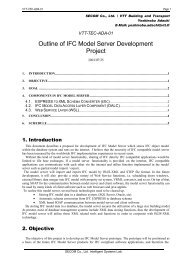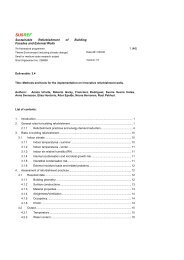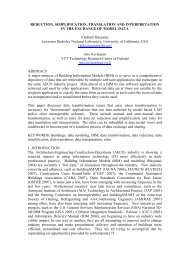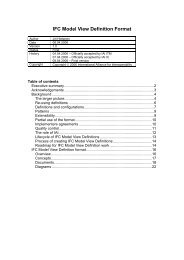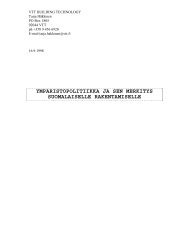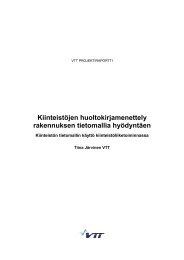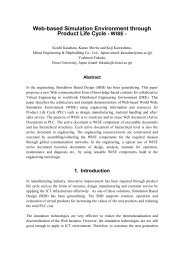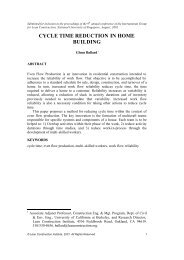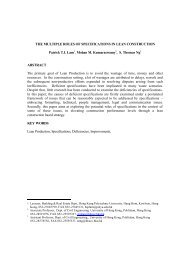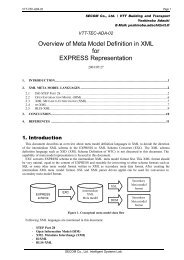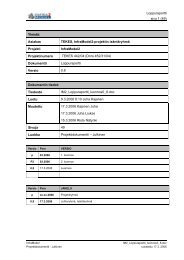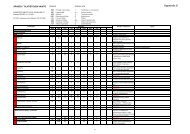- Page 1 and 2: SUSREF Sustainable Refurbishment of
- Page 3 and 4: SUSREF 2 (57) 3.6.3 Insulating with
- Page 5 and 6: SUSREF 2 (57) 2. Objectives The mai
- Page 7 and 8: SUSREF 4 (57) Non-load bearing cavi
- Page 9 and 10: SUSREF 6 (57) Table 1, Different pl
- Page 11 and 12: SUSREF 8 (57) 3.3 Technologies for
- Page 13 and 14: SUSREF 10 (57) 3.4.3 Different conc
- Page 15 and 16: SUSREF 12 (57) Image 4. Example of
- Page 17 and 18: SUSREF 14 (57) In one example syste
- Page 19 and 20: SUSREF 16 (57) 3.5.3 Different conc
- Page 21 and 22: SUSREF 18 (57) Image 11. Insulation
- Page 23 and 24: SUSREF 20 (57) 3.6.1 Thermal bridge
- Page 25 and 26: SUSREF 22 (57) Image 20, filling th
- Page 27: SUSREF 24 (57) Following image show
- Page 31 and 32: SUSREF 28 (57) Image 24. Spots gree
- Page 33 and 34: SUSREF 30 (57) Image 27. Climatic s
- Page 35 and 36: SUSREF 32 (57) The PV façades are
- Page 37 and 38: SUSREF 34 (57) The solar collectors
- Page 39 and 40: SUSREF 36 (57) This system requires
- Page 41 and 42: SUSREF 38 (57) 3.8.7.1 Application
- Page 43 and 44: SUSREF 40 (57) Image 42. Solar wall
- Page 45 and 46: SUSREF 42 (57) Image 46. Solar chim
- Page 47 and 48: SUSREF 44 (57) 4.1 External insulat
- Page 49 and 50: SUSREF 46 (57) External insulation
- Page 51 and 52: SUSREF 48 (57) Other alternatives
- Page 53 and 54: SUSREF 50 (57) • … INFORMATION
- Page 55 and 56: SUSREF 52 (57) Small houses Dfb, Df
- Page 57 and 58: SUSREF 54 (57) 5. References Almusa
- Page 59 and 60: SUSREF Sustainable Refurbishment of
- Page 61 and 62: Some mechanisms are impossible to p
- Page 63 and 64: (source: Weber Saint Gobain) (sourc
- Page 65 and 66: Image 5. Humidity of an un-insulate
- Page 67 and 68: in four principal directions. The r
- Page 69 and 70: For the detailed study, the case 1.
- Page 71 and 72: Image 12. Relative humidity of moni
- Page 73 and 74: In case of mineral wool insulation,
- Page 75 and 76: 1.1.2.2 Replacement of original the
- Page 77 and 78: Table 3. The maximum possible leaki
- Page 79 and 80:
Image 21. Un-insulated wall (left)
- Page 81 and 82:
Image 24. Performance of a solid wa
- Page 83 and 84:
3.2.1 (E1) 100 mm MW + thin renderi
- Page 85 and 86:
Image 28. Water leakage points of d
- Page 87 and 88:
Image 32. Moisture and temperatures
- Page 89 and 90:
Image 36. Water leakage point in a
- Page 91 and 92:
1.4 Krakow Int.EPS 0.00% 147.16 3.8
- Page 93 and 94:
case with actual material propertie
- Page 95 and 96:
Table 10. Different refurbishment m
- Page 97 and 98:
- EPS or PUR foam on inner surface
- Page 99 and 100:
V cap is volume of all capillary po
- Page 101 and 102:
Mould growth Numerical simulation o
- Page 103 and 104:
uptake, the evaporation of water va
- Page 105 and 106:
1.1.4.6 Case study 1: Jyväskylä (
- Page 107 and 108:
The condition and the expected rema
- Page 109 and 110:
Image 46. Results for the PUR refur
- Page 111 and 112:
MW or PUR MW Image 48. Refurbished
- Page 113 and 114:
ESP Image 51. Original unrefurbishe
- Page 115 and 116:
Corrosion (relative to LS) 1,0 0,9
- Page 117 and 118:
The time of refurbishment is the ti
- Page 119 and 120:
The monitoring points of carbonatio
- Page 121 and 122:
Mould Growth Index 6 5 4 3 2 1 Orig
- Page 123 and 124:
1.1.4.13 Variables in the analyses
- Page 125 and 126:
after the risk period is a result o
- Page 127 and 128:
1.1.4.15 References Fagerlund, G. 1
- Page 129 and 130:
SUSREF 2 (11) temperature is actual
- Page 131 and 132:
SUSREF 4 (11) HDD A ( U ref U ren
- Page 133 and 134:
SUSREF 6 (11) Q H Q Q (3) losses
- Page 135 and 136:
SUSREF 8 (11) 2 Significant improve
- Page 137 and 138:
SUSREF 10 (11) Table 9. Effect of I
- Page 139 and 140:
SUSREF 1 (9) Deliverable: D4.2 - Ge
- Page 141 and 142:
SUSREF 3 (9) Paris Month CDD_4h CDD
- Page 143 and 144:
SUSREF 5 (9) The results show that,
- Page 145 and 146:
SUSREF 7 (9) 3 EPS 0.05 0.039 4 hol
- Page 147 and 148:
SUSREF 9 (9) 1.00 0.00 0.00 0.00 0.
- Page 149 and 150:
SUSREF 2(19) Arrays are most often
- Page 151 and 152:
SUSREF 4(19) Figure 2. Solar electr
- Page 153 and 154:
SUSREF 6(19) North facing Electrici
- Page 155 and 156:
SUSREF 8(19) London Electricity pro
- Page 157 and 158:
SUSREF 10(19) 1.4 Discussion For fi
- Page 159 and 160:
SUSREF 12(19) Figure 12. Solar ther
- Page 161 and 162:
SUSREF 14(19) Solar fraction of DHW
- Page 163 and 164:
SUSREF 16(19) Solar fraction of DHW
- Page 165 and 166:
SUSREF 18(19) 3 PVT Photovoltaic an
- Page 167 and 168:
SUSREF Sustainable Refurbishment of
- Page 169 and 170:
SUSREF Sustainable Refurbishment of
- Page 171 and 172:
SUSREF Sustainable Refurbishment of
- Page 173 and 174:
SUSREF Sustainable Refurbishment of
- Page 175 and 176:
SUSREF Sustainable Refurbishment of
- Page 177 and 178:
SUSREF Sustainable Refurbishment of
- Page 179 and 180:
SUSREF Sustainable Refurbishment of
- Page 181 and 182:
SUSREF Sustainable Refurbishment of
- Page 183 and 184:
SUSREF Sustainable Refurbishment of
- Page 185 and 186:
SUSREF Sustainable Refurbishment of
- Page 187 and 188:
SUSREF Sustainable Refurbishment of
- Page 189 and 190:
SUSREF Sustainable Refurbishment of
- Page 191 and 192:
SUSREF Sustainable Refurbishment of
- Page 193 and 194:
SUSREF Sustainable Refurbishment of
- Page 195 and 196:
SUSREF Sustainable Refurbishment of
- Page 197 and 198:
SUSREF Sustainable Refurbishment of
- Page 199 and 200:
SUSREF Sustainable Refurbishment of
- Page 201 and 202:
SUSREF Sustainable Refurbishment of
- Page 203 and 204:
SUSREF Sustainable Refurbishment of
- Page 205 and 206:
SUSREF 1 (13) Deliverable: D4.2 Tit
- Page 207 and 208:
SUSREF 3 (13) Extra Insulation mate
- Page 209 and 210:
SUSREF 5 (13) Life cycle costs - Ca
- Page 211 and 212:
SUSREF 7 (13) Sandwich E2-LCC (eur/
- Page 213 and 214:
SUSREF 9 (13) Solid concrete E1-LCC
- Page 215 and 216:
SUSREF 11 (13) Summary and conclusi
- Page 217 and 218:
SUSREF 13 (13) Künzel Helmut, Kün
- Page 219 and 220:
SUSREF 2 (10) Evaluation criteria:
- Page 221 and 222:
SUSREF 4 (10) W1_Solid wall; Brick,
- Page 223 and 224:
SUSREF 6 (10) W5_Insulated load bea
- Page 225 and 226:
SUSREF 8 (10) Thick noncombustible
- Page 227 and 228:
SUSREF 10 (10) Combustible -2
- Page 229 and 230:
2 (14) refurbishment on the individ
- Page 231 and 232:
4 (14) aggravation indoor air) incr
- Page 233 and 234:
6 (14) 1.2.2 Air quality Air qualit
- Page 235 and 236:
8 (14) Ventilation efficiency -2 th
- Page 237 and 238:
10 (14) If existing wall has infect
- Page 239 and 240:
12 (14) 1.5.3 Acoustics The effect
- Page 241 and 242:
14 (14) 1.6.3 Acoustics The replace
- Page 243 and 244:
Mardjalevic & Rogers, 2006) 2 . In
- Page 245 and 246:
Figure 3: Example room to be simula
- Page 247 and 248:
For Helsinki: Facade Orientation Ea
- Page 249 and 250:
For Bilbao: Facade Orientation East
- Page 251 and 252:
SUSREF Sustainable Refurbishment of
- Page 253 and 254:
3 (18) be removal of cladding, impr
- Page 255 and 256:
5 (18) 2 Significant improvement or
- Page 257 and 258:
7 (18) 3. External insulation (E) 3
- Page 259 and 260:
9 (18) Dfb Dfc 0 -1 0 -1 0 -1 0 -1
- Page 261 and 262:
11 (18) Cfb Cfbw Csa Dfb Dfc 2 2 2
- Page 263 and 264:
13 (18) Cfb - temperate withou
- Page 265 and 266:
15 (18) Dfb - cold, without dry s
- Page 267 and 268:
17 (18) Dfc - cold, without dry se
- Page 269 and 270:
SUSREF Sustainable Refurbishment of
- Page 271 and 272:
3 (3) 5. Cavity insulation Cavity i
- Page 273 and 274:
2 (40) Easiness of maintenance (ex
- Page 275 and 276:
4 (40) Figure 2.1.1. Solid wall - d
- Page 277 and 278:
6 (40) 2.2 Sandwich elements made w
- Page 279 and 280:
8 (40) Table 2.2.2. Vulnerability t
- Page 281 and 282:
10 (40) Maintenance procedures and
- Page 283 and 284:
Figure 2.4.1. Left: Load bearing ca
- Page 285 and 286:
14 (40) Table 2.4.2. Vulnerability
- Page 287 and 288:
16 (40) Dirt and microbial growth.
- Page 289 and 290:
18 (40) Table 3.1.1.2. Vulnerabilit
- Page 291 and 292:
20 (40) Table 3.1.1.3 Continued. Th
- Page 293 and 294:
Figure 3.1.2.2. Retrofitting extern
- Page 295 and 296:
24 (40) Table 3.1.2.2. Vulnerabilit
- Page 297 and 298:
26 (40) Table 3.1.2.3 Continued. Th
- Page 299 and 300:
28 (40) Figure 3.1.3.1 Brick veneer
- Page 301 and 302:
30 (40) Table 3.1.3.2. Vulnerabilit
- Page 303 and 304:
32 (40) 3.2 Internal insulation On
- Page 305 and 306:
34 (40) Table 3.2.2. The effects on
- Page 307 and 308:
36 (40) Table 3.3.1. Vulnerability
- Page 309 and 310:
38 (40) 5. Bibliography Askeland A
- Page 311 and 312:
Zirkelbach D Influence ogf temperat
- Page 313 and 314:
Form. Strictly speaking, form deser
- Page 315 and 316:
The thermal environment also includ
- Page 317 and 318:
It is important to identify the cha
- Page 319:
4. References Heschong, L. (1980).



